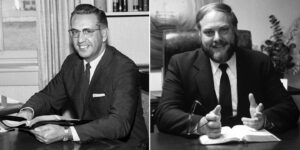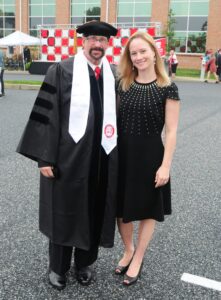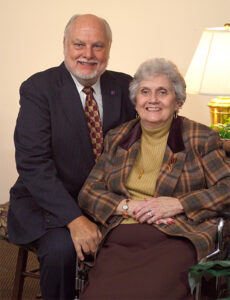 Dr. Stuart E. Lease (’52) & Dr. Gilbert A. Peterson
Dr. Stuart E. Lease (’52) & Dr. Gilbert A. Peterson
Lancaster Bible College’s Third & Fourth Presidents
The years between 1961 and 1979 was a time of blossoming for Lancaster Bible College. During this time, two buildings turned to 15, fewer than 100 students grew to over 400, the library gained over 21,000 volumes, the three-year college program upgraded to a four-year accredited Bible college, and Lancaster School of the Bible and Theology received the name it goes by today: Lancaster Bible College.
No expansion happens overnight, but for 17 years, God worked through the presidency of Dr. Stuart E. Lease (’52) to create a lasting impact on the journey of countless students.
On April 20, 1930, Stuart, the 13th Lease sibling, was born in a small town south of York, Pa. Nine years later, Stuart said a prayer, accepting Christ as his Savior. His life, however, was not truly dedicated to the Lord until years later when he heard how God impacted his brother’s life. It was then, as a high school senior, that Stuart devoted his life to the Lord.
One moment of professed dedication to God resulted in a lifetime of leadership roles and fruitful ministries for Stuart Lease. A year after graduating high school, he married Barbara Rudisill; they were married for 55 years at the time of Stuart’s death in 2004. After a year studying at the Bible Institute of Pennsylvania, Stuart transferred to Lancaster School of the Bible and Theology. Little did he know that he would return to the same school eight years later to lead pivotal expansions in the history of LBC.
After receiving his LSB diploma in theology in 1952, Stuart and his wife relocated to New England where they remained for four years. While in New England, Stuart graduated with a BA from Gordon College, earned his MA from Boston University and served as an interim pastor at three churches.
In 1956, the Leases returned to Pennsylvania, and Stuart became the dean at his alma mater. He served in this capacity for five years before being asked to serve as the school’s third president. Barbara also served alongside her husband in a clerical role.
The expansive growth during Lease’s presidency is too much to list, but mentionable and vital changes shaped the trajectory of the school for years to come:
- January 1962 – LSB adopted its official school colors: white and red.
- Summer 1962 – Mr. and Mrs. J. Martin Esbenshade donated four and a half additional acres to the campus on top of their 1957 gift of farmland.
- July 1962 – The school’s name was officially shortened to Lancaster School of the Bible.
- September 1962 – Two new classrooms were completed.
- September 1963 – The school’s first on-campus dormitory—Esbenshade Hall—along with a maintenance building and outdoor basketball court were completed.
- October 1964 – Lancaster School of the Bible received full accreditation.
- 1970 – The school’s auditorium and gymnasium were completed and the library expanded.
- May 1973 – After receiving approval to offer a BS in Bible, Lancaster School of the Bible officially became Lancaster Bible College.
Each change on campus and in educational standards contributed to the overall growth of students who stepped onto campus each year. When Lease began his presidential leadership in 1961, just 100 students were enrolled, but by the end of his term 17 years later, Lancaster Bible College consisted of over 400 students.
In 1979, the Lease presidential era ended, but his expansive work for the Lord in ministry was far from over. From 1979-1980, Lease founded Scripture Centered Ministries with a mission to present the Bible in various capacities. He then served four years in the pastoral role at Faith Calvary Church.
Before moving to Florida in 1997, Lease carried out his desire to serve the Lord by taking on various leadership roles at BCM International, working in ministry finance with a small association, then pastoring at Faith Bible Chapel.
Needless to say, Dr. Stuart E. Lease was serious when he dedicated his life to the Lord in high school; God saw his faith and worked through him to bring growth and impact in various ministry settings, including LBC.

Dr. Timothy Lease (’15 & ’20) celebrated his 2020 PhD graduation with his wife, Bridget (’17 & ’21).
Dr. Stuart E. Lease passed away Dec. 28, 2004, in Lakeland, Fla. Barbara died in 2009, and their daughter, Rebecca, aged 42, preceded them in death in 2003. Stuart Lease’s generational impact continued through the testimony and mission of his son: Dr. Timothy Lease (’15 & ’20), who earned both a master’s and doctorate degree from his father’s alma mater.
Update: Dr. Timothy J. Lease passed away Nov. 26, 2024. LBC sends our sincere condolences to the Lease family.
Tim Lease practically grew up on the Lancaster School of the Bible campus. One might assume attending LBC was a natural decision for him, but it was a choice not based simply on familiarity but on God’s redemptive work in Tim’s life.
Although Tim grew up in a Christian home, he turned away from God. In 2004, Dr. Peter W. Teague, LBC’s fifth president, attended Dr. Stuart Lease’s funeral, and it was here that God worked through Dr. Teague to begin the journey of reaching Tim’s heart.
Following his father’s funeral, Tim began meeting with Dr. Teague regularly, and after many conversations, Tim returned to the Lord. God’s redemptive work changed the trajectory of Tim’s life; not only did he go on to earn two degrees from LBC, but he also taught as an Adjunct Professor in the Bible & Theology Department.
During his hooding ceremony at his 2020 doctoral graduation, the new Dr. Lease shared these words: “Tim wishes to exhibit the same passion and desire to share Christ with young people that he first witnessed in his father and that was modeled by those under whom he has studied.”
Further Reading: Former LBC President’s Son Is Hopeful for Liver Donor After Cancer Diagnosis. Read more…
Every leader has a role in the process of a growing ministry. Some leaders will have the opportunity to witness the “harvest” of what those preceding them “planted,” while others have the responsibility of tending to the ministry, ensuring a future of growth. Lancaster Bible College’s fourth president, Dr. Gilbert A. Peterson, tended to the “seed” of LBC and initiated a domino effect of growth.
God worked through a radio message by Jack Wyrtzen from New York’s Madison Square Garden to bring 8-year-old Gil Peterson to the point of receiving the Lord as his Savior. After hearing the invitation to accept Christ at the end of the radio show, young Gil talked with his mother about how he wanted to have Jesus in his own life.
Years later, while in youth group, Gil not only met the woman who would later become his wife, but he also dedicated his life to any ministry God had in store for him. This moment of dedication led Gil to marriage, a variety of leadership roles, higher education and a college presidency.
Peterson married Dolores Allen after his first year attending Shelton College. After graduation in 1956, he furthered his education with a master’s degree in Religious Education from New York University, while simultaneously working as the Director of Christian Education at the Reformed Church of Westwood in New Jersey and teaching part-time at Northeastern Bible College.
Following his time in education in New Jersey, Peterson stepped into many additional roles, including Chair of the Department of Christian Education and Academic Dean at Philadelphia College of Bible (Cairn University today) and Director of Christian Education at Trinity Evangelical Divinity School. In 1971, he earned his EdD in Administration and Higher Education.
In 1979, LBC was seeking a new president, and many on the search committee knew of an individual with extensive experience in higher education who they believed would excel in leadership. On July 12, 1979, Peterson stepped into the role of LBC’s fourth president.
Over 20 years tending to the “seed” of LBC, Peterson divided his impactful work into four five-year segments: survive, stabilize, stretch and continued growth.
- Survive (1979-84): At the time of Peterson’s hiring, the most pressing survival issue was a sizeable debt, which had also jeopardized accreditation. His first five years were intense efforts to raise funds, reduce expenses and return to solid financial footing and good standing with accreditors. His relationships with donors not only enabled LBC to survive but also to thrive in the long run.
- Stabilize (1984-89): Community support enabled Peterson to spend the next five years building upon the LBC foundation. The college’s mission and vision were created, open positions were filled, and the student body grew.
- Stretch (1989-93): Significant additions were not only visualized but also realized during this period of the Peterson presidency. With a stabilized mission, full staff and a growing number of students, LBC began offering new programs and degrees, while plans began for new campus building projects.
- Continued Growth (1993-99): Peterson dedicated the final five years of his presidency to strengthening the college’s building plans and higher education opportunities. During this time, the graduate school
and adult degree completion program began. Plans were developed for a new chapel and dining hall expansion. In this time of growth, Peterson also doubled the campus size through strategic land acquisition, which became the future sites for Teague Learning Commons, Charles Frey Academic Center, Peterson and East halls and the soccer and baseball fields.

Gil and Dolores Peterson
Dolores Peterson was diagnosed with multiple sclerosis early in their marriage, and she was bound to a wheelchair for the last decade of his presidency. Dr. Peterson lovingly cared for her, and it was common to see him pushing Dolores’ wheelchair around campus. Their awareness of accessibility issues enhanced that aspect of LBC’s facilities.
Time and again, Peterson attributed LBC’s success during his leadership to the Lord. “I have always believed that God’s work, done God’s
way, will receive God’s supply,” Peterson once stated. “During my 20 years as president of Lancaster Bible College, I saw that proven over and over again.”
Gil Peterson passed away March 13, 2014, but his work at LBC is remembered today, both in tangible and intangible ways. On campus, the Peterson Hall dormitory named in his honor is a testament to the many ways he “tended” to the college he loved.
